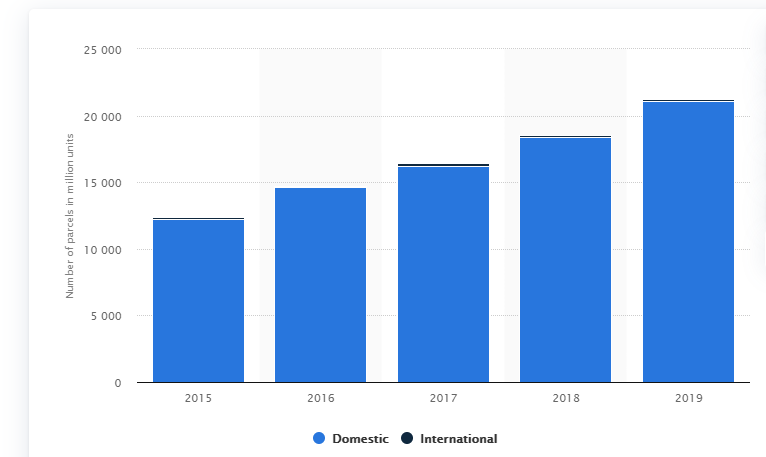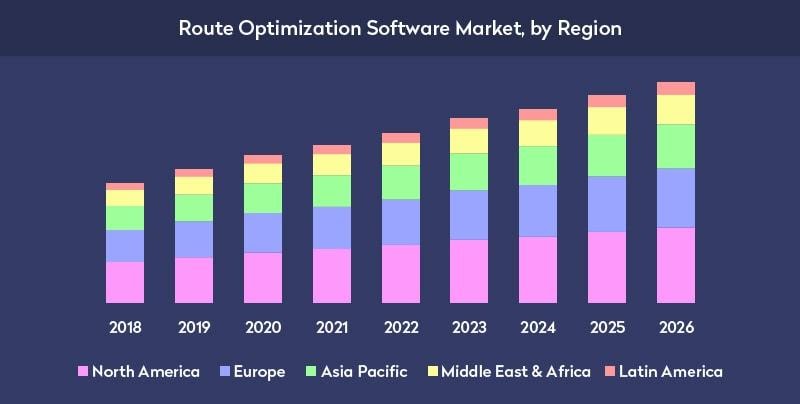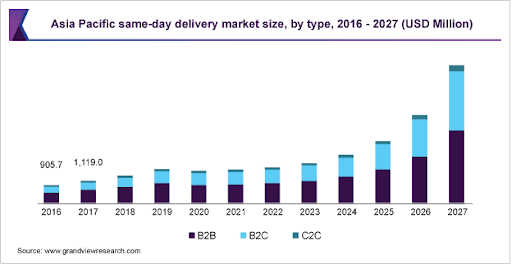Table of Contents
It is absolutely crucial to be digitally prepared for any challenges in your direct-to-consumer business. While staying on top of the progress made by delivery teams to ensure consistency works well, you also need to upgrade your business with the latest technological tools.
What makes an online delivery management system credible? Its performance as a last-mile delivery software. In 2020, eCommerce growth was unprecedented and millions of sellers across the globe became part of the D2C (direct to consumer) ecosystem.
However, what many tend to ignore is the presence of a B2B last-mile delivery tracking software like NetworkON that can help brands create and manage their entire supply chain in a breeze. So, if you don’t find a reliable last-mile delivery management app, you adapt.
So, What are The Top Challenges in Last-Mile Delivery?
Last-mile delivery is the final step of the delivery process. It starts from the final delivery destination (the distribution hub) to the customer’s doorstep. The biggest challenge in this final leg of the operation is to deliver the package as soon as possible by overcoming any hindrances in the process.
In this article, we will take a look at the top challenges of last-mile delivery and what are their implications for the businesses. Let’s begin:
Last-Mile Delivery Market Size is expected to Value USD 66,000M by 2026. (CAGR 8.9%)
Valuates Reports
1. Consumer Behavior:
Sellers are not always at fault. It is evident today as consumers have developed a new sense of urgency when talking about deliveries. In an attempt to woo their customers, retail businesses are also trying to engage their customers regularly. But this whole process works like a double-edged sword.
Just a couple of years ago, 5-7 days for delivery was the normal waiting time, but as many sellers move towards same-day delivery to offer more convenience, competitors have gone a step further by offering delivery in a matter of hours.
In an attempt to deliver outstanding customer service, eCommerce companies are elevating their tactics regularly. However, the sudden rush often affects the quality of service offered during the last mile delivery.
Here a few statistics that will help you understand how the consumer has also changed amidst the competition between eCommerce brands:
- In metropolitan cities, 66% of millennial customers expect delivery within an hour
- 90% of shoppers try to schedule their delivery seamlessly using the tracking option
- 27% of shoppers in the US canceled their orders because they couldn’t get same-day delivery
2. Money Matters:
Why do many businesses don’t sort out last-mile deliveries? One plausible reason is the high last-mile delivery cost. Last-mile delivery constitutes nearly 28% of the overall delivery costs and when you club it with the pressures of same-day delivery, it puts an additional financial burden on the sellers.
eCommerce logistics companies also face an additional burden during the festive or holiday season due to a surge in the total number of deliveries. The pandemic situation has also contributed to the overall rise in costs as nearly every customer is now ordering products online.
3. Efficiency Concerns:
The sole purpose of having a last-mile delivery software is to sort out the issue of efficiency. The surge in demand from the customers is the catalyst behind the constantly increasing efficiency in eCommerce logistics today. But can speed of delivery and efficiency go hand-in-hand? Probably, or maybe not, the answer is subjective.
But what we do know is that the on-demand business model has enabled the companies to make lighting fast deliveries as more and more retail names jump on the on-demand bandwagon.
But to have an automatic dispatching system that improves the efficiency of the deliveries, you need to have the right set of tools at your disposal. A good place to start is investing in a last-mile delivery management system powered by NetworkON.
4. Deliveries in Densely Populated Areas
It’s not easy to deliver packages in densely populated areas. 90,000 packages disappear daily in New York and it is a result of instant gratification that consumers are so used to today. Apparently, unclear addresses during rescheduling, lack of visibility about the targeted area, and traffic congestion also contribute to the challenges in the last mile delivery.
With the right delivery management software, you can get access to features like geo-fencing and route optimization that allow the delivery fleets to move at a reasonable pace. Integration with a tool like Google Maps also assists the team and each member can stay on top of the progress made by the delivery fleet.
5. Outdated Technology:
The demand for deliveries have increased tremendously after the pandemic but that doesn’t mean that every eCommerce logistics company has had the chance to update their technology stack. Many companies are still working with outdated transport management systems that do not cater to the last mile delivery challenges.
The lack of last-mile delivery software pulls the logistics teams back and often leads to sluggish performance during the delivery runs. Thus, it becomes essential to upgrade the systems with a robust last mile tracking system that includes necessary features like route-optimization, vehicle tracking, performance analytics, and more.
15 billion deliveries were requested in 2020. Imagine the plight of companies that didn’t have sufficient infrastructure.
STATISTA

6. Logistics Route Optimization Feature:
Planning a route is often challenging. It is an intellectually exhausting task for many and very confusing for a novice. However, a last-mile delivery logistics software can rescue you if you want to save some fuel.
Failure to incorporate the route optimization feature in your delivery management system can also help you streamline the tentative time of delivery and keep the customers engaged so that they receive their products at the right time.
Rerouting deliveries have always been a headache for eCommerce logistics companies as the last moment changes in address by customers are often difficult to accommodate with the delivery fleet’s schedule. A last-mile delivery software caters to this issue and logistics companies can easily transmit reroute instructions to their squad with a click.
How does that make things better? It reduces downtimes caused by rescheduling and makes the last mile delivery free from any sort of friction.
- Change of directions, stop signs, traffic congestion, mad rush during peak hours, signals and other unpredictable circumstances can cause routing delays.
- If the flow of traffic is blocked there is no way of making the delivery on time. Hence, this results in customer dissatisfaction, frustrated behavior, and irritable moods.
- Many times the food deliveries have to be made in far off areas such as the outskirts of a town. The city boundaries have to be crossed and then the food has to be delivered. Delays are possible when the order to be fulfilled is complicated.

North America leads the Route Optimization software market with a predicted CAGR of 16.67% approx.
GRANDVIEW RESEARCH
7. Friction:
A frictionless delivery is the dream of any eCommerce company. A delivery that is not hindered by constant customer inquiries about the status of their delivery ensured the speedy delivery of order during the last mile run.
Small details like having fixed days and hours available for delivery, not ringing the bell, the condition of the package in transit, and more have always been the culprits behind reduced efficiency.
A last-mile delivery software powered by NetworkON can help companies in creating a frictionless delivery process. By facilitating seamless communication between the delivery personals and the customers, you can cut down on the time needed to streamline the delivery.

In addition to that, eCommerce logistics companies can also attain a smooth delivery process by splitting the geographic area between different delivery personnel. Geographical allocation means lesser trips to the same are. It optimizes the delivery fleet’s resources and also helps in reducing the storage costs.
8. Transparency and Tracking:
Transparency is the key element for an eCommerce company. Since customers want to stay up to date about the status of their package, many eCommerce 3PLs companies have updated their tracking mechanism with tracking codes.
These codes allow the consumers to get better visibility of their pending orders, although, even these codes fall short for the modern-day consumers, who feel entitled to real-time visibility of their delivery and wish to be on top of every phase of the last-mile delivery.
This makes a robust delivery tracking tool an absolute necessity for an eCommerce logistics company. Managers can easily manage the last mile deliveries and customers can stay engaged with real-time tracking of their order through an application. It can also incorporate a digital proof of delivery which reduces friction from the last-mile delivery process.
9. Automated Prioritization and Scheduling:
The volume of eCommerce orders has surged tremendously in the past year and companies are trying to deliver more packages at a faster rate. An AI-powered last-mile delivery solution from NetworkON helps you prioritize and schedule the orders automatically based on a multitude of factors. These include:
- Time of delivery
- Traffic restrictions and roadblocks
- Delivery preferences for location
Based on the size of a package, the software allocated the orders automatically by taking the following factors about the delivery fleet into consideration and sending the details to the concerned delivery person in as soon as possible:
- Specifics of a shipment
- Skill sets
- Type of vehicle
Last Mile Delivery Logistics in the Future
Both logistics and eCommerce businesses are dependent on last mile delivery for success. In order to have a bright future, both parties need to embrace a robust last mile delivery software to streamline the entire delivery process.
How can they do it? By using AI powered technological solutions from NetworkON. Take a step towards the future, choose NetworkON. Here are some of the cool features you can incorporate into your delivery management and last mile delivery solutions:
- Enhanced interface for end-to-end integration of eCommerce and logistics companies
- Regular data collection and analysis to get a better understanding of customer preference and behavior
- A single solution that brings together all stakeholders onto a common platform using smart devices with internet access.
- An omnichannel approach to streamline communication across different nodes in the delivery process
- Improved warehousing and storage facilities with a swift movement of orders
The chain can break anywhere but it will be the original sender who will bear the blame regarding the delivery issues. The agent will in turn pick on the transportation company for the delays caused in delivery. To a certain extent, this can be sorted by creating checkpoints for deliveries but what happens if the packages are extra large and can’t be fitted into checkpoint dimensions?
Wrapping Up
Optimizing the last mile of the delivery process is an excellent opportunity for eCommerce organizations to streamline their processes, offer better services and make the systems more efficient. On top of that, eCommerce companies can also reduce operational costs, create a strong brand and focus on delivering a better customer experience through and through.
Last-mile has been and will continue to be at the forefront of eCommerce and logistics companies. So, if you are an eCommerce or logistics company looking forward to making a mark in the industry and creating a strong brand presence, it is time to get started on the right path.
Hyperactive competition, uncertainty, and new challenges will keep emerging and it is in your hands to innovate the last mile delivery by leveraging the capabilities of AI-powered delivery management solutions from NetworkON.
Start Free Today!
NetworkON is a leading end-to-end delivery management solution that can help you overcome all the modern-day delivery challenges including dynamic route optimization capabilities and geo-fencing.
Get started for free right away here.
To know more about our services or any other queries regarding delivery management solutions, email us at info@networkon.io
Frequently Asked Questions:
Q. Why is consumer behavior listed as one of the top challenges in last-mile delivery?
Consumer behavior has evolved, with increased expectations for faster deliveries. The shift from a standard delivery time of 5-7 days to same-day or even within an hour has created challenges for businesses trying to meet these new demands and maintain service quality.
Q. What percentage of overall delivery costs does last-mile delivery constitute, and how does it affect businesses, especially during peak times or holidays?
Last-mile delivery constitutes nearly 28% of overall delivery costs. During peak times or holidays, the surge in deliveries adds extra financial pressure on businesses, contributing to the challenges in managing last-mile delivery effectively.
Q. How does the efficiency concern in last-mile delivery relate to the surge in demand from customers, and what role does technology play in addressing this issue?
The efficiency concern arises due to the increased demand for faster deliveries. Technology, such as last-mile delivery management software, is essential to improve efficiency. Investing in the right tools, like NetworkON, helps enhance the delivery process and meet customer expectations.
Q. What are the challenges faced in delivering packages in densely populated areas, and how can delivery management software address these issues?
Challenges in densely populated areas include unclear addresses, lack of visibility, and traffic congestion. Delivery management software with features like geo-fencing, route optimization, and integration with tools like Google Maps can help address these challenges and improve the pace of deliveries.
Q. Why is outdated technology listed as a challenge in last-mile delivery, and how does it impact the performance of logistics teams?
The demand for deliveries has increased post-pandemic, but some companies still use outdated transport management systems. This lack of updated technology hinders logistics teams, resulting in sluggish performance during delivery runs. Upgrading to modern last-mile delivery software is essential for overcoming this challenge.
Q. How can a last-mile delivery software help reduce friction in the delivery process, and why is frictionless delivery crucial for eCommerce companies?
A last-mile delivery software like NetworkON can facilitate seamless communication between delivery personnel and customers, reducing inquiries and improving efficiency. Frictionless delivery, with fixed delivery days and hours, helps ensure a smoother process, enhancing customer satisfaction and reducing operational costs.





Открыть счет в binance
Thanks for sharing. I read many of your blog posts, cool, your blog is very good.